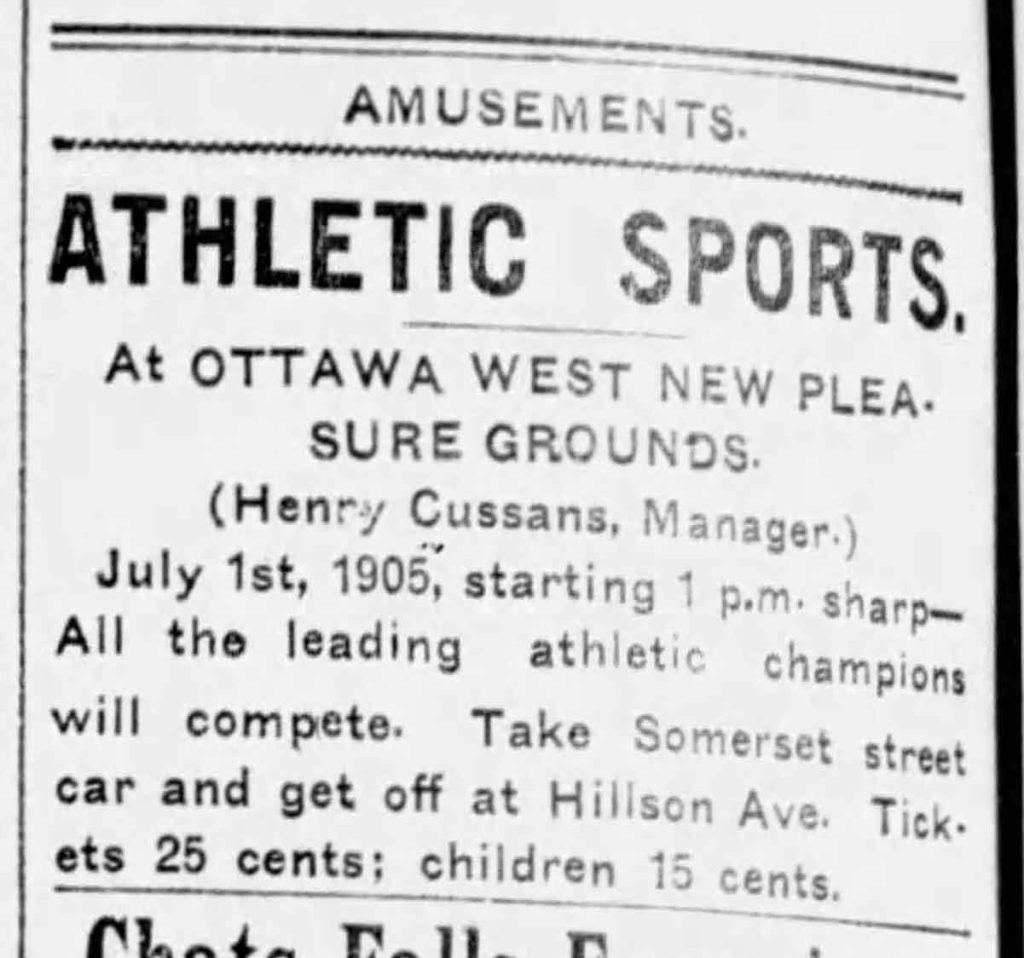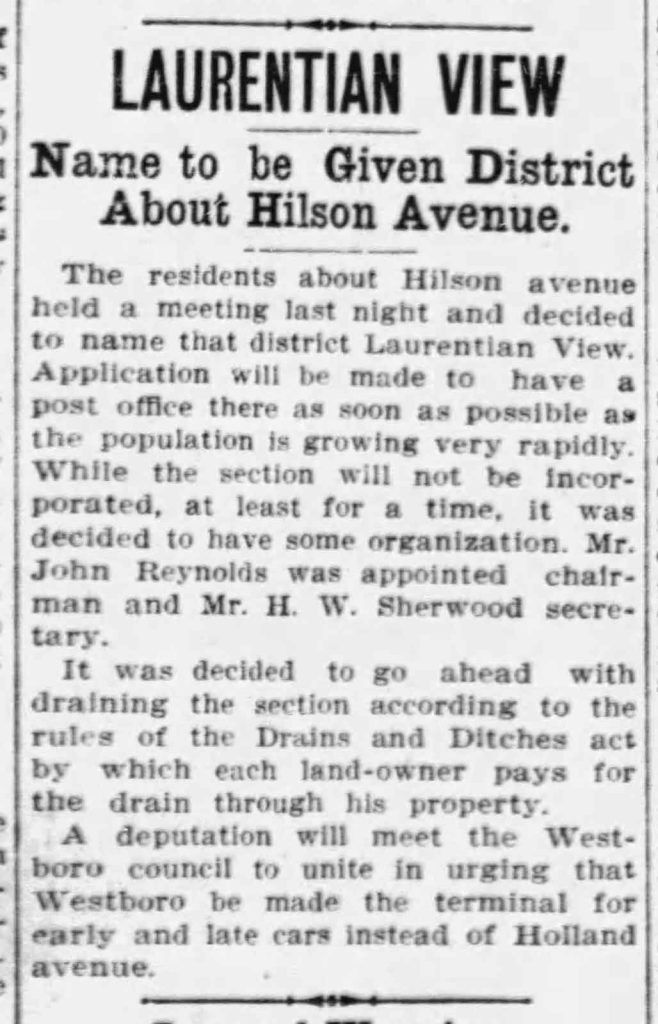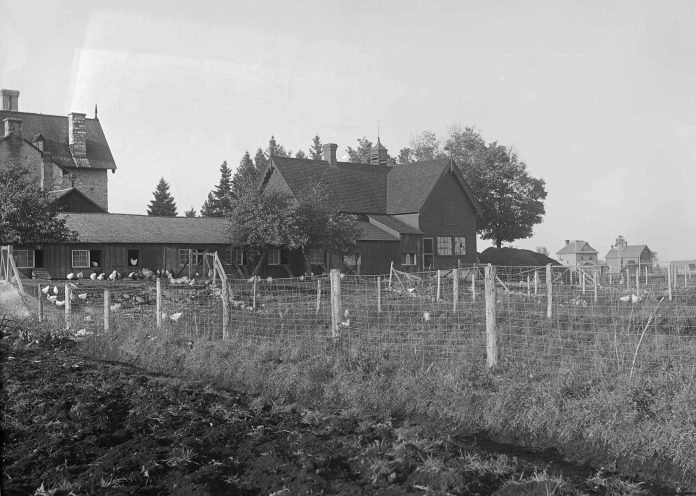By Dave Allston
One of the historic hidden gems of Kitchissippi is the neighbourhood of Hampton-Iona. Though just barely 600 meters wide, it is home to three well-known parks (Hampton, Iona and Byron), two malls (Westgate and Hampton Park), a notable stretch of Richmond Road and Hilson School. Several important pieces of local heritage are also still standing, including two of Kitchissippi’s oldest structures!
Hampton-Iona is the Savannah, Georgia of west-end Ottawa, with its vintage houses on wide lots backing onto picturesque parkland. Over time, Kirkwood Avenue has emerged as the primary thoroughfare road through the community, but, historically, it was Hilson Avenue that was the community’s main street. And it was around Hilson where one of the first planned residential subdivisions of the west end was created, including showplace homes mixing with agricultural, commercial, industrial and community uses.
Hampton-Iona (which includes the area between Richmond and Scott, the rear lot lines of Tweedsmuir Avenue on the west and Island Park Drive on the east) can trace its borders and history all the way back to the late 1700s, when the original surveys of Nepean Township were made. The western border was a dividing line between old farm lots 32 and 33 that, at one time, had wood fences installed along its length, and which now forms the border between the Hampton-Iona and Westboro communities, even if the fences are long gone.
Old lot 32 was actually split into a north and south half, with Iona Street being the dividing line between the two. Hence why Iona travels in this area at a non-parallel line to all other streets in the neighbourhood, but parallel to Scott and Carling, the north and south borders of lot 32.
Nepean Township’s first settler Ira Honeywell arrived in Nepean in 1810 (in the vicinity of Woodroffe). His father Rice Honeywell had acquired the north half of lot 32 in 1804, perhaps considering moving there from Prescott someday. He never did, and Rice sold the land in 1821.
The buyer, Peter Aylen, arrived soon after and constructed what is believed to be half of the stone Aylen-Heney house located on Richmond Road east of Kirkwood, making it one of Ottawa’s oldest remaining structures. It stood for many years as a cottage on the estate of John Heney.
Meanwhile, just to the east, as Nepean Township gradually began to draw in new residents along the Richmond Road, prominent Ottawa merchant James Dyke constructed a three-storey stone house on the south side of Richmond in 1864-65 known as “The Elms.” This stone house was the pride of 19th century Richmond Road, and still stands today, sadly hidden behind the modern condos that dwarf its impressive architectural features. Prior to becoming the Soeurs-de-la-Visitation Convent, it was the home to George Holland, Ottawa entrepreneur and long-time owner and editor of the Ottawa Citizen.

These two houses hold exceptional heritage value in Kitchissippi and are as much a part of the Hampton-Iona identity as its parks and malls.
It was George Holland and his wife Alison Hilson Holland who set the wheels in motion for the development of the neighbourhood. In May 1895, they filed a subdivision plan which laid out a new street at the south end of the property (north of Carling), bisected by Holland Street (now Kirkwood), that created 19 small three-acre lots intended for market gardeners to come and enjoy the open groves and lush growing pastures that the orchards of the old Heney farm yielded.
The Hinds family (Hugh Sr. and Hugh Jr.) took great interest in the area and acquired eight of these lots right away. They had big plans for the area, including the establishment of a cemetery at one time, but, ultimately, both men passed away at young ages in 1897 and 1900, respectively. Before his passing, Hugh Jr. constructed a house (627 Kirkwood) in 1895, which stood for a long time as the third-oldest home in Hampton-Iona. It was demolished just last month.
598 Kirkwood Ave. has an addition at the front matching the original back two-storey frame home, which was built in 1900 for Fanny Hinds (the widow of Hugh Sr.) until her passing in 1917.
Another excellent turn-of-the-century home stands at 115 Shannon St., built by Charles Rochon in 1904 for its long-time occupant Howard Chamberlin, an early letter carrier in the late 1800s and original member of St. George’s Parish. This house has had a front row seat to vast farmland, streetcar tracks and now busy Byron Avenue and the ever-evolving residential neighbourhood.
Some of the earliest houses in Hampton-Iona stood in areas long changed by the establishment of the Queensway, the Carling Avenue bypass and Hampton Park mall. If you were to stand at the lights next to the fire station on Carling 120 years ago, you would be among a small cluster of five early houses, the first of which was built by Charles Pettit in 1896 (demolished 1955-56), and the last to survive was built by Augustus C.M. Switzer, a life-long Nepean resident who died in 1920, whose name lives on as the namesake of a street in the area. His old farmhouse at 666 Kirkwood stood until 1987 where the Hampton Court commercial building was built in its place.
The first decade of the 1900s was a boom period for the area that saw the community established through the gradual laying out of small individual plans (there are over twenty late 19th century to early 20th century subdivision plans that make up Hampton-Iona!). The arrival of the streetcar down Byron Avenue in 1900 made travel to and from the central part of Ottawa easy, and the streetcars stopped right at Hilson Avenue.
One of the first enterprises in Hampton-Iona was led by Henry Cussons. Cussons was one of Bytown and Ottawa’s biggest names in organized sports in the 19th century. For many years, he ran competitions and trained top athletes. In 1904, at the age of 78, he acquired three acres of land (the southern loop of Westhaven Crescent today), encircled it with a tall fence, and built a running track and other athletic facilities, promoting it as “Ottawa West’s Pleasure Grounds.” He invited Ottawans out to the Hilson Avenue streetcar stop to participate in competitions. It certainly helped put the area on the map.
In the same vein, the renowned St. Hubert’s Gun Club (the subject of this past February’s Early Days column) had opened in 1901 in a field where now stands the house of Dawson and Bevan Avenues.
In 1909, the residents around Hilson and Kirkwood (which was then called “Holland Street”) met and decided to establish their own independent village, and break away from loose associations with Westboro or “Ottawa West” (the official name for the neighbourhood north of Richmond Road divided by Carleton Avenue).

One hundred residents gathered at the Hilson Avenue grove (aka Iona Park, though Iona Street was known as “Beatrice Street” at the time) on Friday Aug. 13, 1909, “which was prettily illuminated with lanterns and decorated by flags.” A vote was taken on a new name for the community, with the following contenders: Rothesay, Irvington, Edgewood, Gladwood, Woodlyn, Mayfield, New Town and Laurentian View. In a landslide, Laurentian View was selected the winner. Simply, the name came from the fact that due to its elevation, and a lack of practically any buildings towards the Ottawa River, most of the neighbourhood had an unobstructed view of the Laurentian Mountains.
George Randall was selected as the first chair of the new association and Henry W. Sherwood as secretary. At the inaugural meeting, residents discussed their most pressing issues of the village, which included fire protection, better streetcar accommodation in the early morning, the lighting of the district, securing a post office and the issue of drainage.
The first commercial businesses in Laurentian View opened that same year, 1909: a small grocery store opened by Ernest Philip on the ground floor of his home (inside long-gone 493 Hilson), and an Ottawa commercial operation, the Ottawa Wire Fence and Gate Company, which opened a factory on Hilson in 1910.
The stage was now set for Laurentian View to quickly become one of the west end’s fastest growing communities, led by one of Ottawa’s most successful companies of the 20th century, which would have its beginning and incredible success all occur on Hilson Avenue.
Read more in part two in the June issue of Kitchissippi Times!
(Top) An article announcing the new Ottawa West Pleasure Grounds in the Ottawa Citizen on June 28, 1905. Photo courtesy of the Ottawa Citizen. (Above) An article announcing the new village of Laurentian View in the Ottawa Citizen on Aug. 13, 1909. Photo courtesy of the Ottawa Citizen.
